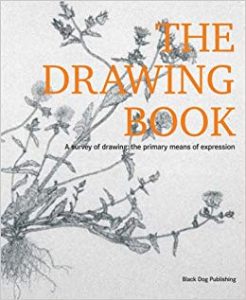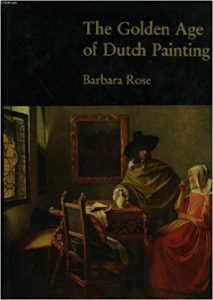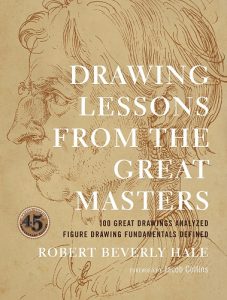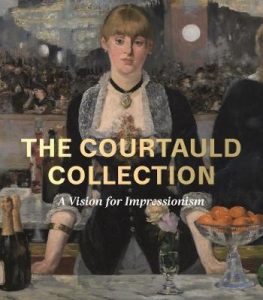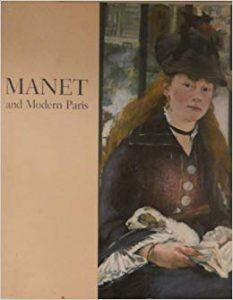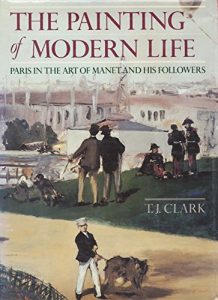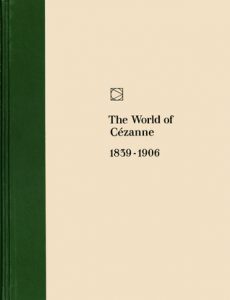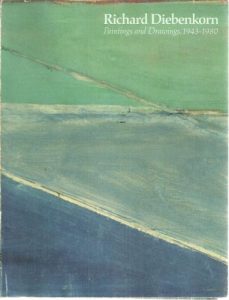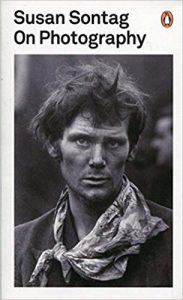
Partnership with Météore Films for Frederick Wiseman’s “Monrovia, Indiana”
9 April 2019
Interview with 2019 Spring Visiting Fellow Ian Leslie
26 April 2019The Library is pleased to present the Culture Picks for the month of April, curated, researched and written by Library volunteer Mike Duffy.
April in Paris, ah, yes, the charm of spring. It is a wonderful time for (art) lovers and Culture Picks by Mike Duffy highlights three of the wonders of the season: an excellent survey of five centuries European and Russian drawings and prints drawn from the Pushkin Museum’s vast collections at Fondation Custodia; a view of the best of the Impressionist movement with precursors and heirs at Fondation Louis Vuitton, the legacy of great English collectors who brought modern French art to Britain; and a vibrant exhibition of mid-20th century photographs by a gifted Italian photographer at The Galerie Nationale du Jeu de Paume.
As always, we’ve selected books from our collection to go with the cultural visits. These books are displayed in the Members’ Lounge and available to be checked out.
Guest blogger: Mike Duffy lives in Paris following his retirement from a career in university teaching and management. He spent his first 30 years in Pennsylvania (born in Pittsburgh, college and grad school in Philadelphia), then spent a bit more than that in California where he taught accounting and finance at the Universities of California (Berkeley), Southern California and San Francisco. He can now be found in art museums, historic sites, and concert halls throughout the city.
THE PUSHKIN MUSEUM — 500 YEARS OF DRAWINGS BY THE MASTERS
FONDATION CUSTODIA
Through 12 May 2019
The Fondation Custodia once again brings to Paris an outstanding exhibition, in this case 200 European and Russian prints and drawings spanning five centuries, showcasing major artists and movements through examples almost never seen since their acquisition by Russian collectors and state museums. Works on paper are particularly sensitive to light and even those in much smaller collections are displayed sparingly, so this is an opportunity to revel in watercolor, goache, pen and ink or colored pencil finished drawings, preliminary sketches and prints, featuring famous as well as unknown artists from the past 500 years. With roughly half of the pieces from before 1900 and half after, this is a veritable history of Western art.
While the survey of drawing and prints from 1500 to 1900, the first half of the exhibition, is in itself impressive in scope (Véronèse, Tièpolo, Watteau, Renoir, Degas), there are several standouts among the 100+ works. Albrecht Dürer’s twisting and turning pudgy putti from 1495 displayed in a case in the first room start the earliest Renaissance drawings on a fun note while Parmigianino’s delicate, sweet, red ink Études de têtes (Studies of heads, 1525-1527) reveal the skill and attention to details that characterize the period. Among four Ruben’s pieces, Centaur conquered by Love (1605-1608) shows how lifelike strength can be captured by black chalk (while a marble version resides in the Louvre), and in a few lines a small Rembrandt from 1650 reveals a quick impression of a pose, a real person even if only seen from the back. A true highlight is Fragonard’s The Attack (late 1770s) the brown ink fluid lines of which attract your eye across the third room. This surprising, intense drawing contains dynamic movement as one boxer recoils or flinches away from the fist of the other. Adding a distinctive and special note to the first part of this exhibition are several Golden Age drawings of humble cottages in the Dutch countryside and four Romantic period works of dreamy melancholy by the notable German artist Caspar David Friedrich (1774 – 1840). As the 19th Century section closes, a preliminary sketch for a painting by Vincent Van Gogh illustrates the role of drawing in preparing for another work and, in this case, the careful, detailed attention Van Gogh paid to planning the colors he would use in a work influenced by Japanese prints.
Among the excellent examples of 20th Century drawings, there are concentrations of works by Picasso, Matisse, and Léger. The avant-garde, the experimenters, the Futurists, the Blue Rider appear here — Robert Delaunay, Franz Marc, Paul Klee, Giorgio De Chirico, Amedeo Modigliani, among others — presenting a panorama of modern styles and techniques. About a quarter of this half of the exhibition, though, is found in the works of several major figures of the century. An alcove containing 6 Picasso pieces brings the start and development of Cubism to the fore, while 7 Léger works round out Cubism and his particular move beyond its initial thrust. In an exceptional display, 7 Matisse artworks appear, confirming his status as one of the great innovators of his time. In particular, La Danse (The Dance, 1909), is one of several studies and finished masterpieces on this theme from the century’s first decade, others now residing in New York’s and Paris’ Museums of Modern Art, the Barnes Foundation in Philadelphia, and Saint Petersburg’s Hermitage. All these share his great interest in color and dramatic, sweeping lines to form figures gliding through space. One truly stellar portrait — of Lydia Delectorskaya — is revealed in a few long, black charcoal lines, unmistakably modern, unmistakably masterful, unmistakably a high achievement near the close of his long career.
A great feature of this exhibition is the extent of 20th Century works by Russian artists, some unknown outside the borders of their country. The great Kandinsky is represented by four works, including Composition E (around 1915), with red, blue, purple, pink, yellow and green moving across the paper in a stellar example of contemporary attempts to capture sound and rhythm through color and line. There are also three Chagalls, an early work by Kasimir Malevich (before his move to geometric abstraction), beautiful pastels by Natalia Goncharova and Mikhaïl Larionov and others known from their careers in Paris or Berlin. The real surprises, though, are works by artists unknown outside Russia, for example, Alexandre Deïneka (1899-1964) whose 1920’s Soviet propaganda drawings of idealized female factory workers or May Day poster painters exemplify post-Revolution artistic endeavors or Pavel Filonov (1883-1941) whose marvelous, modern pen and ink drawings fell into disfavor in the Stalinist USSR. Among others, Alexandre Kouprine, Aristarkh Lentoulov and Nikolaï Koupreyanov stand out as artists of fine, intriguing works which will be seen by many for the first time in this exhibition.
Since the 1950s, the mission of Fondation Custodia has included bringing rarely seen works, mostly on paper, to Paris. This outstanding exhibition drawn from the Pushkin Museum’s collection of 350,000 prints and 27,000 drawings surely more than meets its goal.
Recommended books from the Library collection:
THE COURTAULD COLLECTION — A VISION FOR IMPRESSIONISM
FONDATION LOUIS VUITTON
Through 17 June 2019
Paintings in The Courtauld Collection — A Vision for Impressionism at the Fondation Louis Vuitton are among the best known examples of Impressionism, reproduced frequently in books and on the Internet, but the experience of seeing them in person is unmatched by any of those pretenders to authenticity. The colors — vibrant or deep or sheer, light washes — and the textures of paint, paper and canvas impress in a way a flat page or screen cannot. Seurat’s dots, Manet’s light brushstrokes, Van Gogh’s thickly applied paint, Gauguin’s bold colors entrance viewers. The 110 works, which include 60 paintings and graphic pieces, present a major part of the legacy of Samuel and Elizabeth Courtauld, great collectors and philanthropists during the early 20th Century. Samuel, in particular, wanted to shake the traditional British art establishment by introducing the works of Impressionist painters and, especially, of Cézanne and Gauguin. In its Frank Gehry-designed building in the Bois de Boulogne, the Fondation Louis Vuitton introduces the vision of the Courtaulds, a vision focused on those 19th Century French painters seeking the freedom to paint outdoors, to paint shimmering sunlight on water, to paint their impressions.
Where to begin when there are rooms filled with paintings by Manet or Cézanne or Gauguin? To start with the Manets, those pre-Impressionist works which surprise and delight with their attention to ordinary people in ordinary settings, what a feast there is across three decades. In 1863 Manet deliberated shocked Parisians with a nude who is not a goddess sitting with bourgeoise picnickers in Le Déjeuner sur l’herbe (Luncheon on the Lawn, 1863); in 1874, in Banks of the Seine at Argenteuil he employs thick paint to capture a sunny outdoor scene; and in one of his best known paintings, The Bar at the Folies-Bergère (1882), he places the viewer directly in front of the bored, oddly vacant gaze of a barmaid standing behind a beautiful still-life of bottles and fruit and in front of the theatergoers who are mere dabs of paint. In a mirror-reflection behind her is a well dressed man looking for a drink or maybe more.
Then to the works by Cézanne and Gauguin. There is one of the five versions of Cézanne’s well known card players, a carefully balanced composition of two Provençale locals intent on their game; a still life; a quick, evocative sketch of Mont Sainte-Victoire, one of his 46 watercolors of this mountain; and another depiction of Mont Sainte-Victoire (one of 35 oils of this favorite subject) framed on the left by large trees with limbs stretching across the canvas mirroring the Japanese prints which brought a new vision to French painters late in the 19th century. Samuel Courtauld was enchanted by Gauguin’s paintings and those from the South Seas, Te Rerioa (1897) and Nevermore (1897) with their strange settings and enigmatic symbols appear along with The Haystacks (1889) with its flat fields of color and lack of perspective in a portrayal of Breton fieldworkers in customary local garb. Together these showcase the range of this self-taught renegade.
On to Renoir, Monet and Van Gogh. There are early Renoir pieces such as the inviting spring, Chatou (c. 1873) painted in bright greens dappled with bits of white and yellow, that light palette so typical of the Impressionists and The Skiff (1875), a delightful work with bright sunlight, reflections on water, and varied brushwork to convey the differences among plants, water and sky. La Loge and Eva Gonzales are two 1874 depictions of social life during the lush Third Republic with turned-out women checking out the crowd and being checked out in turn. Later in the exhibition, the warm Portrait of Ambroise Vollard (1908) rounds out a revealing view of the painter not dominated by fleshy, pink nudes. There is also a lovely, off-center bouquet, filled with pink, white, blue and green painted by Monet in the early 1880s, and the very high Impressionist painting of the Seine at Argenteuil (1873) with its magnificent Autumnal yellow trees reflected in the river and luminous sky and water. While the Van Gogh self-portrait presents the troubled artist with a bandaged ear, an icon of the Romantic vision of the artist as a troubled soul, Wheat field with cypresses (1889) with its golden grain bending in front of purple/blue hills, under swirly white clouds and bound by the off-center tall cypresses is a masterwork of color and imagination.
The blockbusters may catch the eye, but small works by Seurat and Degas will reward time spent with them. There are six small outdoor scenes by Seurat from the early 1880s painted on wood panels, all illustrating his experimenting with varied brushstrokes and styles to evoke the play of light on water — broad brushstrokes and cross hatching in the depiction of a painter in a boat and short strokes in others to capture shimmering water. A final small panel of can-can dancers is in the style for which he is best known, the collection of colored dots which the eye combines to form a picture, a method based on the developing sciences of vision and color. Across the room, however, amidst a display of drawings there is a surprising Seurat nude from around 1880, viewed from a distance and then up-close the sensuous figure emerges from dark pencil shading on rough paper, a wonder of technique and skill, another style variation essayed during the short life (1859-1891) of this outstanding artist.
Degas, on the other hand had a very long career during which he, too, experimented with technique, types of paper and light. The dark, somewhat mysterious Woman at a Window (c. 1871) was made with paint drained of its oil, then thinned with turpentine, making it look like a watercolor as Degas tried novel lighting, materials and the smudging typical of watercolor to create a matte effect. In the nearby picture of two ballet dancers, he captures the luminous effect of the then-new electric lighting, while Woman Adjusting Her Hair (c.1884) employs pastels on tracing paper, another experiment and another scene which is very much the modern rather than the stylized presentation of high society or classical figures.
This exhibition begins and ends with paintings a bit outside the boundaries which define the Impressionist movement, but it reflects the personal tastes of the Courtaulds rather than a curatorial selection to make a point and it is the richer for that. There are, for example, several Cézanne letters, well displayed side-by-side with easy-to-read print presentations which attracted more viewers than the usual displays of letters and manuscripts in exhibitions. In a true grace note, there are also 10 lovely watercolors by the English painter J.M.W. Turner (1775-1851) collected by Samuel Courtauld’s brother. Predating the Impressionists, these plein air works reveal the sensitivity to light, color and mood which would dominate the later artists’ works. The Fondation Louis Vuitton aims to present extraordinary collections by individuals and institutions and without a doubt The Courtauld Collection — A Vision for Impressionism fulfills the promise.
Recommended books from the Library collection:
LUIGI GHIRRI — THE MAP AND THE TERRITORY
GALERIE NATIONALE DE JEU DE PAUME
Through 2 June 2019
A colorful exhibition brightens the Jeu de Paume, bringing 1970s Italy to Paris through the exceptional photographs of Luigi Ghirri (1943 – 1992). He wrote, “I always thought that photography was a language to see and not to transform, obscure, change reality.” He sought to combine his earliest experiences with photography—looking at a family photo album and an atlas—in a brief career delighting in the reality of maps and the region of the country in which he was born. This is a celebration of The Map and the Territory of Luigi Ghirri, a celebration well worth joining.
The surveyor who became a photographer still loved straight lines; direct, framed views; places more than people; and these essential elements appear in the earliest photographs in this exhibition. There is clear, straight line geometry with a lot of prominent vertical lines and interesting surface textures such as in a Zurich photo with the pavement prominently featured in the foreground. Ghirri mostly avoided fancy angles to shoot straight-on urban sites in the early 1970s. People appear from behind and are generally part of the shoot rather than individuals. His photographs appear in series or sets and one presents doorways and windows always with a plant but never with a person. These very modern, flat pictures emphasize right angles, vertical lines, planes of color and are fun even if formal; one exceptionally beautiful photo shows a green and pink rose bush behind a silver gray fence and in front of a gray wall with a very dark gray shadow. Horizontal lines, too, could attract Ghirri and his 1972 photograph of the side-to-side lines created by a Paris stairway contrasting with the verticals of a pleated skirt testifies to how fine his eye was even at the earliest stages of his career. He once summarized his approach: “No violence, no visual-emotional shock and no exaggeration, but silence, lightness and rigor to be able to relate to things, objects, places.”
The amateur picture taker who became a professional, full-time photographer never stopped using the small Canon camera and Kodachrome film that were used by everyday picture takers. He avoided the art-school, black and white, experimental work of those hoping for acceptance by museums (which did not afford recognition to photography) and, instead, worked as commercial and amateur photographers did with color film. This is not to say that he took pictures casually. In fact, he rejected chance as part of his method which distinguishes his work from that of many street photographers of the time and he cared about the fixing of colors and a matte finish through the developing process. His photos, therefore, often combine everyday subjects which might be found in a family album with exacting composition under an indisputably fine eye. 1970s Italian life in his hometown of Modena and its region fed him images of buildings, advertising posters, reminders of the consumer culture which flourished after World War II, all of which he captured not as banal aspects of modern life, but as reflections and moments for reflection on “desires, dreams and memories”. In fact, he saw photos as presenting a pause in a world increasingly overwhelmed with images both static and moving.
Even though most of his work is utterly realistic, several pieces are exceptional, not just because these abstracts are rare among his oeuvre, but they are also exceptionally beautiful. A 1972 blurred picture of sailors, abstract in black, white, yellow and blue circles is a wonder, but it is his Atlante (1973) project based on an atlas that astounds. Moving from photos of pages of an atlas, one of those beloved books of his childhood, to closer and closer photos of those pages, the works evolve from gray and green map sections, grainy, with, perhaps, a curving red line, a graphic design or a word to completely abstract works, strangely beautiful. Among the L’Île-Rousse series (1976), there appear flat gray planes at an oblique angle, marked with single, small squares with only a bit of mountain and light blue sky angled above. The reality behind this tremendous geometric simplicity is revealed only later, at the same time revealing Ghirri’s artistry and instinct. Also from L’Ïle-Rousse is a picture of black horizontal lines across a light blue sky, seeming to be another abstraction, which can be seen to be wires when viewed up close.
He started out as a practical worker, a building surveyor, and at the end of his life was a respected photographer and deep thinker about photography, representation and life. He once explained that he let the photograph’s “magic reveal to our eyes the spaces, the objects, the landscapes that I want to represent.” In the Jeu de Paume’s recreation of a 1979 exhibition of his works we encounter that magic.
Recommended books from the Library collection:



